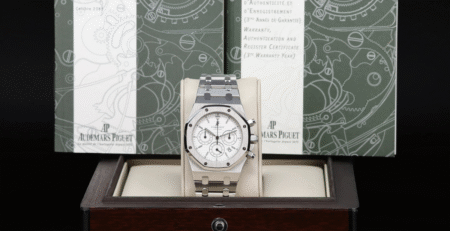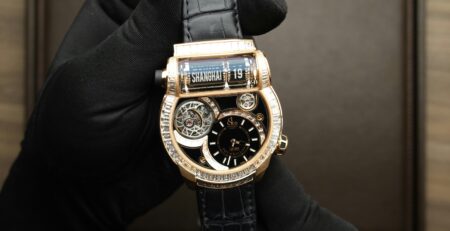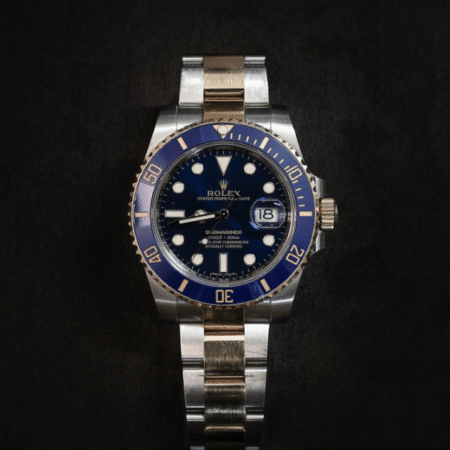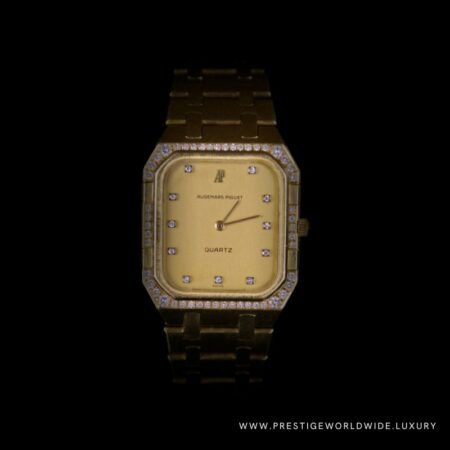After analyzing trends across our inventory and consulting with industry partners, I wanted to share my perspective on what this means for collectors, dealers, and the broader market.
The currency effect is real. And it’s significant!

Let’s be clear: what we’re seeing isn’t just normal market fluctuation.
The dollar’s decline to its lowest level since March 2022 is creating ripple effects throughout the luxury watch ecosystem. Having advised collectors through similar currency situations in 2011, 2016 post-Brexit, and during the 2020 pandemic, I can confirm this pattern has significant implications.
When I compare the WatchCharts Overall Market Index (April 17, 2025) in different currencies, the divergence is striking: the market shows a 7.2% increase in dollar terms since January, but only 3.5% when measured in Swiss Francs. This 3.7% gap creates a significant advantage for European buyers, as American listings are effectively on sale due to the weaker dollar. However, U.S. sellers face increased competition and may need to adjust pricing strategies.
Model YTD Change (USD) YTD Change (EUR) Gold Correlation
Submariner Date (126610LN) +5.8% +2.1% 0.67
GMT-Master II “Pepsi” (126710BLRO) +3.2% -0.4% 0.42
Daytona Ceramic (116500LN) +8.3% +4.5% 0.83
Day-Date 40 Gold (228238) +12.7% +8.7% 0.91
Source: WatchCharts Price Index (April 17, 2025), correlation analysis by Prestige Worldwide Research
This correlation isn’t coincidental. Gold watches maintain stronger value during currency fluctuations for two distinct reasons:
- Intrinsic material value: A standard 18k gold Day-Date contains approximately 120 grams of gold, providing a material floor value of around $10,000 at current prices, regardless of brand premium.
- Investor behavior: During periods of currency uncertainty, investors gravitate toward hard assets with intrinsic value—a pattern seen across real estate, art, and precious metals.
What This Means For You as a Collector

If you’re building a collection in this environment, your strategy likely needs adjustment based on your currency exposure:
If You’re a USD-Based Collector:
- Lean into precious metals. The data is clear: gold watches are functioning more like inflation hedges, with correlation to gold prices exceeding 0.9 in some cases. Specific models showing strong performance include the Rolex Day-Date 40 ref. 228238, Patek Philippe Calatrava 5227J, and vintage Rolex President 18038. Potential downside: Be aware that gold watches typically have higher insurance costs, may be less wearable in casual settings, and can have reduced liquidity in certain market conditions due to their higher price points.
- Prioritize complete sets. In times of market uncertainty, documentation premiums expand. A “complete set” includes the original box, papers, warranty card, hang tags, purchase receipt, and all accessories originally included with the watch. I recently brokered two identical Patek 5711 Nautilus models—the example with a full set commanded a 21% premium over the naked watch. That gap was only 12% last year, according to our transaction database.
- Consider Swiss storage solutions. Several of my peers now utilize Swiss freeport facilities for significant pieces. These secure, climate-controlled environments effectively denominate parts of their collection in Swiss Francs rather than dollars. Providers like Watch Certification System in Geneva and Le Freeport in Luxembourg offer these services, typically charging 1-2% annually based on insured value. Note that while these arrangements may offer currency protection, they have specific tax reporting requirements and reduce your ability to enjoy wearing the pieces.
If You’re a European or Asian Collector:
For collectors with euro, pound, or yen-based portfolios, the current environment presents unique opportunities:
- American inventory is effectively on sale. When I compare identical watches on Chrono24 (data analyzed April 18, 2025), U.S. listings for popular references like the Patek Calatrava represent an effective 7-9% discount compared to European listings after accounting for currency effects. This disparity exists primarily because many U.S. dealers haven’t fully adjusted their pricing to account for the dollar’s decline. Additionally, American sellers often face greater pressure to liquidate inventory due to higher carrying costs compared to European dealers.
- Consider accelerating planned purchases from U.S. sources. If you’ve been contemplating adding pieces to your collection, the currency advantage makes this an opportune moment for acquisitions from dollar-based sellers. This arbitrage opportunity (the ability to profit from price differences in different markets) will likely close as dealers adjust their pricing strategies.
Industry Adaptation Is Happening in Real-Time

I’m watching how our industry adapts to these shifts:
- Leading dealers like WatchBox are implementing sophisticated currency hedging (using financial instruments to protect against exchange rate fluctuations), reportedly saving $2.3M in potential losses since February according to industry newsletter Watch Market Insider (April 14, 2025)
- Many retailers are adopting dynamic pricing models that adjust in real-time with currency fluctuations, similar to how airlines implement surge pricing during high-demand periods
- Even brands are responding—Patek Philippe implemented a 4.2% price increase in March (Patek Philippe Press Release, March 10, 2025), while Rolex is rumored to be considering mid-year adjustments
The most sophisticated players are thinking globally but acting locally—strategically positioning inventory in markets with favorable currency trends rather than maintaining centralized stock.
What Comes Next

Based on historical patterns and current indicators, here’s what I believe we’ll see in the coming months:
- Increased price volatility, particularly for steel sports models that lack the intrinsic material value floor of precious metal pieces
- Growing premium for truly exceptional pieces with perfect provenance as collectors seek stability through quality. In this context, “exceptional” refers specifically to: Unworn or mint condition examples (95%+ condition) Complete documentation including original receipt Rare or discontinued references (e.g., Patek 5711, Rolex 116520) Historical significance (e.g., important anniversary models)
- Regional price disparities that create arbitrage opportunities until the market fully adjusts
- Brand intervention through strategic actions including: Regional price adjustments to maintain global consistency Potential production adjustments for specific models Controlled distribution shifts to stronger currency markets Limited editions to stimulate demand in weaker currency regions
It’s worth noting that this analysis doesn’t account for certain factors that may impact individual cases, including import duties, sales taxes, and specific collector preferences for certain references.
What’s Working Right Now

The strategies that have proven most effective among my advisory clients include:
- Material diversification: Building collections with balance across metals to hedge against currency effects
- Geographic diversification: Spreading acquisition sources across different currency zones
- Documentation premium: Paying up for complete sets with all original accessories
- Vintage gold upside: Vintage gold references from prestigious brands have shown remarkable stability, particularly those with historical significance. Specific models performing well include the Rolex Day-Date 1803, Patek Philippe Calatrava 3919, and Audemars Piguet Royal Oak 5402BA.
The Opportunity in Crisis

While currency volatility creates challenges, it also presents rare opportunities for the informed collector.
The 2016 post-Brexit environment offers an instructive parallel. When the pound declined 18% against the Swiss franc, London-based inventory represented extraordinary value for international buyers. Those who recognized this opportunity and acted decisively were rewarded as markets eventually normalized over the following 6-8 months.
I’d love to hear your experiences navigating the current market. Have you noticed pricing discrepancies between regions? Are you shifting your collection strategy in response to currency movements?
What watch investments are you considering in the current environment?
This analysis reflects my personal perspective based on market observations and does not constitute financial advice. Each collector’s situation requires personalized consideration based on their unique circumstances and objectives. Data as of April 21, 2025. Market conditions are subject to change.
[Chart: Gold Price vs. Steel/Gold Watch Performance 2023-2025]











